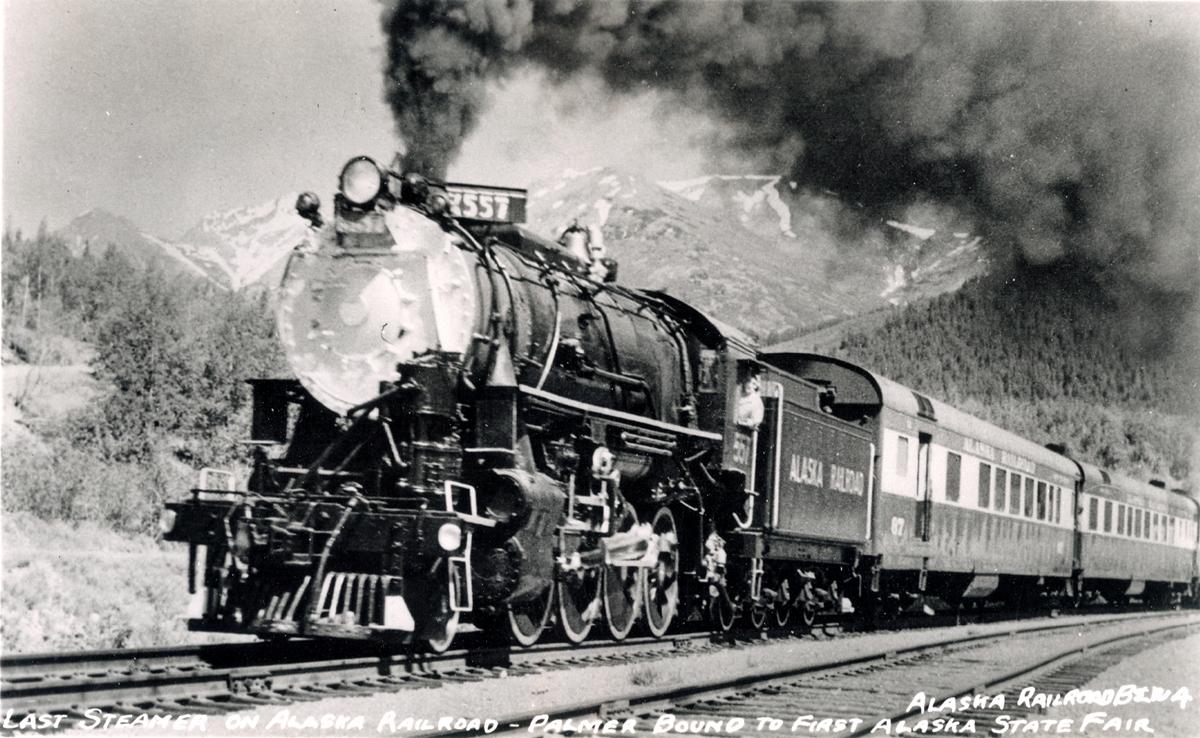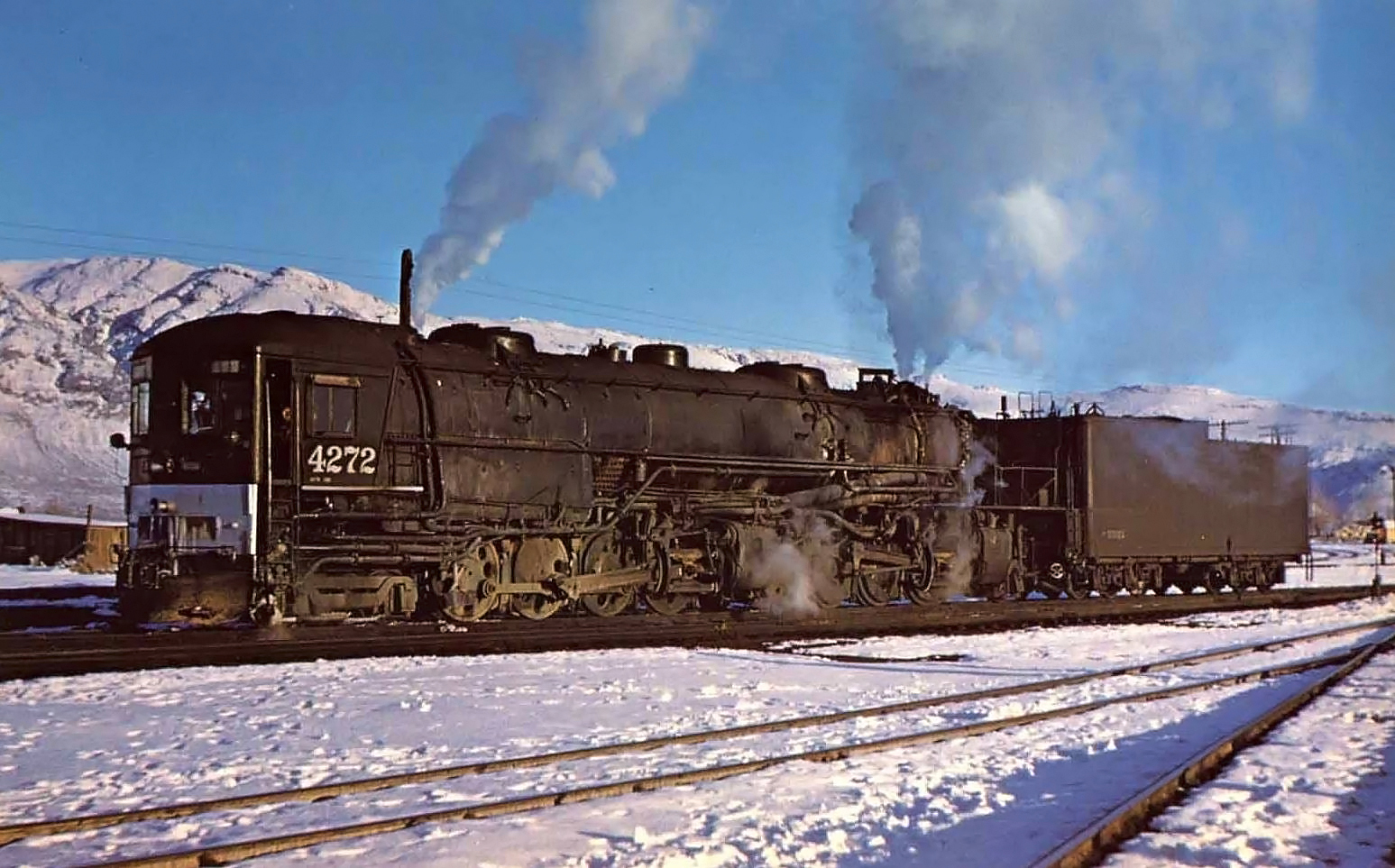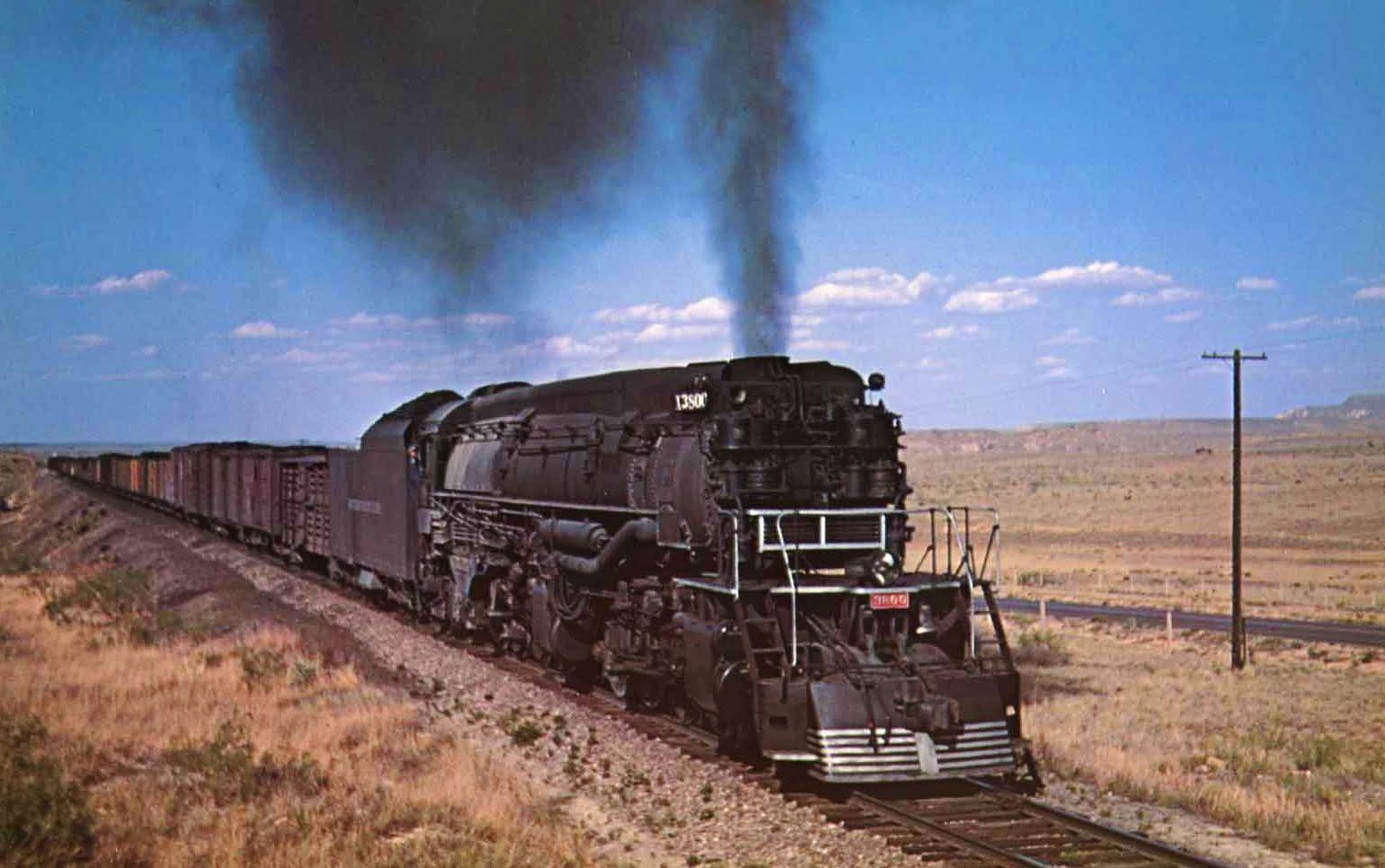In reply to DjGreggieP :
It definitely looks like it should have been at least built as a 2-6-0. A 2-6-2 probably would have looked even more normal.
In reply to DjGreggieP :
It definitely looks like it should have been at least built as a 2-6-0. A 2-6-2 probably would have looked even more normal.
The primary purpose of the USATC steam locomotives was to replace destroyed equipment for the US's allies during WWII under Lend-Lease. European allies' equipment was getting trashed by airborne attacks and artillery at a rapid rate and most of their manufacturing capacity was at work building, guns, ammo, tanks and planes. So the USATC designed a series of locomotives that were relatively compact and could clear European bridges, tunnels and loading clearances, as well as being light enough to easily ship to Europe and not damage the European trackbeds. The locomotives were relatively crude, with an emphasis on fast construction, easy maintenance and saving money. They didn't need to be particularly robust or equipped with all the latest fancy gadgets like stokers and power reversers and lubricators, as the odds were that the engines would be shot to E36 M3 in short order. Railroads that continued to operate them in secondhand usage after the war reported issues with frames and fireboxes cracking and bearings running hot, simply because the engines weren't expected to last that long.
Some stayed stateside, either being manufactured too late in the war to warrant sending overseas or as relief power for US railroads in the event of an invasion or air attacks on US railroads. Of those, some of them were kept on by the military, some were scrapped and others were sold secondhand. Virginia Blue Ridge Railroad had a couple 0-6-0s, and Alaska Railroad had a handful of S-160 Consolidations and a couple 0-6-0s as well. Two of the Alaska RR 2-8-0s remain, with one, the #557, currently being restored to operation.

An interesting S-160 that stayed in the Army's ownership and was used at Fort Eustis was the #611. These days its a pretty rough hulk, and it was inoperational before Fort Eustis got rid of their steam program in 1967, but its interesting in that at some point in its life after its construction, and likely in the 1950s, it received an unusual one-off experimental rotary cam valve gear setup from Franklin that has Type D cast into it, as well as some patents referring to it as Type D. Type A and Type B saw limited usage on some PRR stuff like T-1s. No one knows what Type C was or if such a thing existed. Type D is a much simpler setup that traded off power for being easier to operate. But, because it is similar to what was used on PRR T-1s, and there is a group building a new PRR T-1, the #611 has become very popular these days as the gear is being disassembled and studied and reverse-engineered for usage on the new T-1, while spare parts will be made for the #611 in return.

The #611 is one of only 2 locomotives left in the U.S. these days with rotary cam poppet valves. The other being the streamlined C&O 4-6-4 #490 at the B&O Railroad Museum. The #490 uses older, more complicated Type A. PRR T-1s used Type B.
How does it work? Beats the hell out of me. Regular link-style valve gear is black magic to me. The rotary cam poppet valve stuff is advanced black magic. Looks cool though. And apparently it worked, because it spent a while over on the Maryland & Pennsylvania Railroad while still owned by the Railroad Battalion undergoing testing in regular conditions. Perhaps the USATC was looking at retrofitting all their remaining stuff with it. Seems odd, as this was the tail end of the steam era.
Apparently the #611 is a well-traveled engine too. Spent time at Fort Eustis, was loaned to the Ma & Pa, then returned to Fort Eustis, then was retired, then got sold to the Texas State Railroad. The TSRR thought they were getting one of the good, operating S-160s from them and was horrified to find out that the #611 was a beat-up pile that was missing a bunch of parts and had some weirdo one-off valve gear. It then went to the Tennessee Valley Railroad Museum. And now belongs to a gentleman in Maryland who's a heavy equipment dealer who is having the #611 restored, possibly to operation.
USATC locomotives, particularly the S160s (they built 2100+), littered Europe in the post-WWII era, much like flatfender Jeeps. Britain received over 400, which it would then export across pretty much every major European country after the war. They also were shipped to Africa, as well as China, India and Korea. Its interesting to think that the USATC was training on S160s for the possibilty of the US invading China and commandeering S160s that they had given to them back in WWII.



The UK has several S160s restored to operation. Greece still has several stored. Not in museums or scrapyards or preserved, but owned by their major railways and stored. Poland owned a few until relatively recently, at which point they destroyed them with old Cold War munitions (the locomotives were taking up space, the munitions were taking up space, the munitions were free and acetylene is expensive)
There was also the S100, which looked more like your traditional British tank engine, but were manufactured by Vulcan and Porter, both US companies.

There was the S118, which was a Mikado built for a variety of gauges and sent to Africa, Alaska, Australia, India, the Middle East and Central America

And the S200 was another Mikado that was Lend-Leased to Great Britain, who then exported them to the Middle East. Several were also sent to Italy after the Allies liberated it, and another batch was sent to China
I have honestly learned an incredible amount about the history of steam engines. Makes me wish I had someplace to display a model train layout.
In reply to DjGreggieP :
I've been slowly working on building a small N scale layout that won't take up much space in my office. I haven't started laying track yet because of coronavirus and the fact that the turnouts I ordered are made in China and have been on back order for a while now. I have plenty of flex track and an idea of a track plan. Today I got DCC++ up and running on a tiny piece of test track. It was fun to run a loco back and forth by giving it commands from my keyboard.
Space is one issue and budget is the other...this stuff is not cheap. I have most of what I need to get things up and running once I get my turnouts. I am figuring out the code to use an arduino to control turnouts and perform block occupancy detection so I will be able to automate some trains while I operate mine.
In reply to T.J. :
For goodness sake man, figure out the size of your fingers and start a build thread. ![]()
T.J. said:In reply to DjGreggieP :
Space is one issue and budget is the other...this stuff is not cheap.
And N-scale is the cheap stuff. Go look at the O-scale stuff. An O-scale locomotive will cost you as much as a good used car.
In reply to T.J. :
There used to be a cool hobby store about 2 hours from me, had models kits, trains, planes, supplies, everything. I got to visit the store once before they closed and now the only hobby shop I can find specializes in RC models only. My father 'had' a bunch of old HO stuff but I have no idea were it ended up, I may need to go digging for it, then figure out the 'were' to set it up
The Southern Pacific "Cab-Forwards" were always a cool example of problem-solving. The Southern Pacific had a number of steep mountain grades through the Sierras, requiring big pulling power, so they were purchasing big 2-6-6-2s and 2-8-8-2s. These routes through the mountains had a total of 40 miles of tunnels and snow sheds though, and they were having issues with smoke from the big engines asphyxiating crews. The SP originally tried running the locomotives in reverse, putting the engineer and fireman upwind of the stack, but the tenders made visibility too poor and the trucks on them were also not designed to lead, meaning they had to operate at reduced speed.
So the SP did a little thinking and decided the solution was to turn the locomotive around and leave the tender where it was. Then they closed off what used to be the back of the cab and added some windows, put a headlight up there and reconfigured the controls a little. They were pretty crude-looking, like something thrown together in someone's backyard, and definitely freakish, particularly with the odd "whale-back" tenders that SP was fond of. The beauty of this setup was that Espee was already firing their Malletts on oil, so unlike a coal locomotive which would be near impossible to move the coal to the firebox at the front of the engine, they just ran longer oil feed pipes under the running boards up to the firebox


Southern Pacific was pleased with the first of the Cab-Forwards and how they eliminated the asphyxiation trouble. Crews also like the unsurpassed forward visibility offered by them. Southern Pacific's only gripe with the early examples was that they were relatively low speed. So as future batches arrived, the made subtle changes, adding an axle to the lead truck to make them a 4-8-8-2 or a 4-6-6-2, as well as slowly making the cabs look more and more refined, culminating with the somewhat streamlined front end on the final class AC-12s.

Despite being designed for use in the mountains, the power and speed of the later Cab-forwards led to them showing up all over the SP's system. Although they were excellent performing engines, they were not without their faults. One, was that crew's were constantly worried about safety in the event of a collision, as there was no longer a whole locomotive ahead of them to absorb the impact. There was at least one crew killed when an AC-class struck a car at a grade crossing. Another was that, because the firebox was now at the front of the engine, you had to run with the boiler water level right up near the top, because when climbing a grade, the water wanted to run away from the top of firebox, which would hot spot it and cause a boiler explosion. And the third issue was that the oil feed pipes required perfect maintenance, because if they developed a leak, they would drip on the drive wheels and cause wheelslip. A particularly bad case of this happened when one stalled in a tunnel due to an oil leak. Trying to get moving again, they broke a coupler and sent the air brakes into emergency lockup. While trying to fix the coupler and air line, the oil leak caught fire inside the tunnel and killed the crew.
There was also the SP AC-9s, which were an AC-8 turned back around the proper way to make a 2-8-8-4 Yellowstone. They wore a semi-streamlining similar to Gs-6 4-8-4s.

kazoospec said:In reply to T.J. :
For goodness sake man, figure out the size of your fingers and start a build thread.
Started a build thread just for some structure kits I put together. I still am stuck wating for turnouts to come from China so I can start building my actual layout.
In reply to NickD :
I knew that SP had the cab forward engines, that they were oil burners, and that the genesis of the design was making tunnels less unpleasant for the engineer and fireman, but I didn't realize that they were just a regular engine turned around backwards. Meaning that I never noticed that the pistons were behind the wheels they powered instead of in front. I wonder if they had to redesign parts of the running gear to make it operate better in reverse.
In reply to T.J. :
Both B&O, with their N-1 4-4-4-4 "George H. Emerson" and the PRR with their Q1 4-6-4-2 duplexes tried mounting the second set of cylinders in the rear and with the rods going forward. Both of them suffered troubles with the rear cylinders from the heat and grit/cinders from the firebox. SP never tried this design, but the SP was never a company that was particularly heavy on experimentation. Even the cab-forwards were pretty conventional, once you got past the look.


These days, there is only one Cab-Forward left anymore, AC-12 #4294. The #4294 was the last one left and SP was going to scrap it until Sacramento convinced them to donate it to the city instead so that they could display it next to C.P. Huntington, the SP's first steam locomotive, which was also on display in Sacramento. Construction on I-5 led to it being moved later on, being stored in the SP's shops until '81, when it was moved to the California State Railroad Museum. At one point, it was eyed for restoration to operating condition, but the cost and UP's current attitude towards "foreign" locomotives has prevented that from going anywhere.

In reply to NickD :
Have you seen RailMapOnline?
SP's tunnels would rear their head again in the early-1970s. SP's began having troubles with their SD45s overheating while hauling through tunnels. The radiators were mounted up high in the flared section of the long hood and were getting heat-soaked by the exhaust in tunnels. So EMD cooked up the SD45T-2, which was an SD45 with the Dash 2 electrical upgrade package and a revised cooling systems for tunnels (the T). They moved the radiators down from the roof, getting rid of the SD45's distinctive batwings, to the walkway, where the would pick up cleaner cool air from ground level. Another visual distinction was that the rear face of the long hood was no longer peaked, but flat across. The system worked well, and SP bought a large fleet of them. Most of them were later overhauled to SD45T-3s in later rebuilds or downgraded to SD40 engine packages and renamed SD40T-3 and SD40-2Ts.
A regular SD45 hood

SP SD45T-2 #9400

A used SD45T-2 in the ownership of KCS

There was also another tunnel motor, the SD40T-2, which was a 3000hp SD40-2 with a similar tunnel cooling system as the 3600hp SD45T-2. There were a little harder to distinguish from a regular SD40-2, as the SD40-2 did not have the flared radiator wings on the hood. Unlike the SD45T-2, the SD40T-2 was not a strictly Southern Pacific locomotive either, as Denver, Rio Grande & Western bought 79 of them as well.
An SD40T-2.

A regular SD40-2 with the high-mounted radiators at the rear

And the very slight difference between an SD45T-2 and an SD40T-2

You'll need to log in to post.